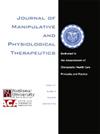成人慢性腰背痛初级保健治疗综述》(Umbrella Review of Primary Care Treatments for Adults With Chronic Low Back Pains)。
IF 1.4
4区 医学
Q4 HEALTH CARE SCIENCES & SERVICES
Journal of Manipulative and Physiological Therapeutics
Pub Date : 2023-06-01
DOI:10.1016/j.jmpt.2024.03.002
引用次数: 0
摘要
研究目的本研究旨在识别、批判性评估和总结成人非特异性慢性腰背痛(NSCLBP)初级保健治疗的有效性证据:我们对NSCLBP初级保健治疗方法的系统综述进行了总体回顾。我们在 PubMed 和 Cochrane 图书馆数据库中检索了 2007 年 1 月至 2021 年 3 月间发表的评估 NSCLBP 成人初级保健治疗方法的随机对照试验 (RCT) 系统综述。两名审稿人使用 AMSTAR 核对表独立评估了这些系统性综述的质量。我们选择了偏倚风险较低或中等的系统性综述,并根据 GRADE 分级标准对证据进行了分级:在最初符合纳入标准的 66 篇系统综述中,我们选择了 19 篇具有低度或中度偏倚风险的系统综述进行分析。这些综述共包括 365 项研究,涉及 62 832 名参与者。有证据表明,某些初级保健治疗对改善 NSCLBP 患者的疼痛和功能具有中度到高度的有效性。这些治疗方法包括非甾体抗炎药和阿片类药物与安慰剂的比较、脊柱手法与运动/物理疗法的比较以及MBR与运动/教育/建议/不治疗的比较:结论:针对成人 NSCLBP 的特定初级保健治疗方法的建议仍无定论。需要进一步开展高质量的系统综述和研究性临床试验,以更好地了解这些治疗方法的有效性。未来的研究性临床试验应优先评估非甾体抗炎药、阿片类药物、脊柱推拿和MBR,因为在某些比较中,它们似乎有望改善NSCLBP的疗效。本文章由计算机程序翻译,如有差异,请以英文原文为准。
Umbrella Review of Primary Care Treatments for Adults With Chronic Low Back Pain
Objectives
The purpose of this study was to identify, critically assess, and summarize evidence of the effectiveness of primary care treatments for adults with non-specific chronic low back pain (NSCLBP).
Methods
We conducted an umbrella review of systematic reviews focusing on primary care treatments for NSCLBP. We searched the PubMed and Cochrane library databases for systematic reviews of randomized controlled trials (RCTs) evaluating primary care treatments for adults with NSCLBP published between January 2007 and March 2021. Two reviewers independently assessed the quality of these systematic reviews using the AMSTAR checklist. We selected systematic reviews with a low or moderate risk of bias and graded the evidence based on Grading of GRADE criteria.
Results
Among the initial 66 systematic reviews meeting our inclusion criteria, 19 systematic reviews with low or moderate bias risk were selected for analysis. These reviews included a total of 365 studies involving 62 832 participants. The evidence suggested moderate to high support for the effectiveness of certain primary care treatments in improving pain and function in NSCLBP patients. These treatments included NSAIDs and opioids compared to placebos, spinal manipulation versus exercise/physical therapy, and MBR versus exercise/education/advice/no treatment.
Conclusions
Recommendations for specific primary care treatments for NSCLBP in adults remain inconclusive. Further high-quality systematic reviews and RCTs are needed to better understand the effectiveness of these treatments. Future RCTs should prioritize the assessment of NSAIDs, opioids, spinal manipulation, and MBR, as they appear promising for improving NSCLBP outcomes in certain comparisons.
求助全文
通过发布文献求助,成功后即可免费获取论文全文。
去求助
来源期刊
CiteScore
3.00
自引率
7.70%
发文量
63
审稿时长
29 weeks
期刊介绍:
The Journal of Manipulative and Physiological Therapeutics (JMPT) is an international and interdisciplinary journal dedicated to the advancement of conservative health care principles and practices. The JMPT is the premier biomedical publication in the chiropractic profession and publishes peer reviewed, research articles and the Journal''s editorial board includes leading researchers from around the world.
The Journal publishes original primary research and review articles of the highest quality in relevant topic areas. The JMPT addresses practitioners and researchers needs by adding to their clinical and basic science knowledge and by informing them about relevant issues that influence health care practices.

 求助内容:
求助内容: 应助结果提醒方式:
应助结果提醒方式:


